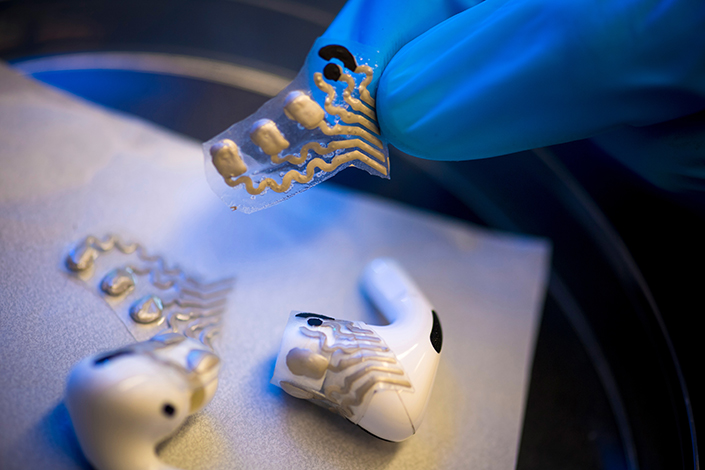A pair of earbuds can be turned into a tool to record the electrical activity of the brain as well as levels of lactate in the body with the addition of two flexible sensors screen-printed onto a stamp-like flexible surface.
The sensors can communicate with the earbuds, which then wirelessly transmit the data gathered for visualization and further analysis, either on a smartphone or a laptop. The data can be used for long-term health monitoring and to detect long-term neuro-degenerative conditions.
The sensors, developed by a multidisciplinary research team of engineers at the University of California San Diego, are a lot less cumbersome than state of the art devices currently used to sense the brain’s electrical activity and the body’s sweat secretions. They can be used in the real world during exercise, the researchers showed.
While in-ear sensing of several physiological parameters is not new, integrating sensing of brain and body signals in a single platform is. The breakthrough was made possible by the combined expertise of biomedical, chemical, electrical, and nano-engineers.
Data from an electroencephalogram (EEG), which measures electrical activity in the brain, and sweat lactate, an organic acid the body produces during exercise and normal metabolic activity, can be combined for a variety of purposes. For example, they can be used to diagnose different types of seizures, including epileptic seizures. They can also be used for monitoring effort during physical exercise and monitoring levels of stress and focus.
The researchers validated the data collected during this proof-of-concept study against data obtained from commercially available dry contact EEG headsets and lactate-containing blood samples. The data the flexible sensors collected were just as effective.
The team describes their work in an article appearing on the cover of the October 2023 issue of Nature Biomedical Engineering.
The researchers foresee a future, in which neuroimaging and health monitoring systems work with wearable sensors and mobile devices, such as phones, earbuds, watches, and more to track brain activity and levels of many health-related metabolites throughout the day. This would allow users to enhance brain and body capabilities. The team also envisages a future in which the capabilities of existing wearable audio devices, such as earbuds, can be considerably expanded to gather a much wider range of data.
“Being able to measure the dynamics of both brain cognitive activity and body metabolic state in one in-ear integrated device that doesn’t intrude on the comfort and mobility of the user opens up tremendous opportunities for advancing health and wellness of people of all ages, anytime and anywhere,” said Gert Cauwenberghs, a professor in the Shu Chien Gene Lay Department of Bioengineering at UC San Diego.

Full paper: In-ear integrated sensor array for the continuous monitoring of brain activity and of lactate in sweat
Why earbuds?
The team felt that the ubiquitous wearing of earbuds translated to an untapped potential for gathering brain and body signals conveniently, both for wellness and health.
“Earbuds have been around for decades, and in many ways were one of the first wearable devices on the market,” said Patrick Mercier, a professor in the UC San Diego Department of Electrical and Computer Engineering. “This research takes important first steps to show that impactful data can be measured from the human body simply by augmenting the capabilities of earbuds that people already use on a daily basis. Since there are no major frictions to using this technology, we anticipate eventual wide scale adoption.”
The ear has sweat glands and is close to the brain, said Yuchen Xu, co-first author of the paper, and a postdoctoral researcher in Cauwenberghs’s lab. “It’s a natural entry point–people are used to wearing earbuds,” he said.
